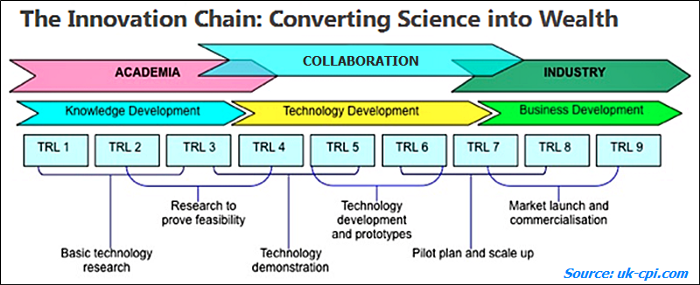Speaking to a room full of engineers — academics, postgrads and PhD candidates — last week I ran through the ins and outs of why (and how) they should commercialise and communicate their research. It was my first public talk, invited as a keynote speaker to the Engineers Researcher Symposium at the University of Sheffield, to share what I’d learnt in the five years since graduating.
GUEST POST: Written by Alex Stockham, IN-PART’s Communications Manager
Originally published here
My take-home was that commercialisation and communication lead to more relevant academic research that improves lives and provides solutions to our global dilemmas.
By raising the profile of research, either through commercialisation or communication, it allows academics to establish relationships and build networks both within and outside their field. Exchanging ideas and getting feedback encourages thinking in more practical terms. And the resulting conversations can lead to collaborations that advance research in ways that individual academics can’t alone.
As well as the big picture, I also outlined the duty that academics have to give back to society in return for being funded by the taxpayer. To this end, the UK research funding councils set up the Research Excellence Framework (REF) in the mid-2000s. The REF ranks each university in terms of the quality and impact of its research, accordingly allocating funding and resources based upon the assessment.
The ‘impact’ measured in the REF is defined as “an effect on, change, or benefit to the economy, society, culture, public policy or public services, health, the environment, or quality of life beyond academia”. When the next REF takes place in 2021, the percentage of a university’s score based upon their researcher’s impact will increase from 20% to 25%.
As I explained to the engineers, research commercialisation is one of the most direct ways they can ensure that their work has impact. But due to limitations in funding or resources, it’s often necessary to bring in an industry partner to help validate, scale-up and commercialise a discovery. This step between a breakthrough and a working prototype is often referred to as the ‘valley of death’ for innovation. Fortunately, it can be bridged by collaborating with industry.

The Technology Readiness Level scale, showing the need for industry collaboration to get early-stage university research (TRL 1–3) to a working prototype (TRL 4–7)
Take Bell Labs, for example, an industrial research and development (R&D) company, now owned by Nokia but originally founded by Alexander Graham Bell in the late-1800s. Through their history of collaborating with universities, Bell Lab’s R&D teams are credited with the invention of the world’s first lasers, transistors and solar cells, as well as satellite and telephone communication.
On the life sciences side of the equation, earlier this year LifeArc, a British medical research charity, received £1-billion for a licensing agreement they made with Merck. This deal was based upon early-stage research conducted by LifeArc researchers (then the Medical Research Council) that laid the foundations for a new cancer immunotherapy treatment, Keytruda, which is now available on the market.
And through IN-PART, an online matchmaking platform for university-industry collaboration (akin to a match.com for research commercialisation), we’ve initiated over 5,000 new interactions between academia and industry since the platform launched in 2014. The conversations resulting from these interactions have led to everything from grant funding for collaborative research, co-development projects, and testing new materials and proprietary compounds, to product development, exclusive global licensing deals, and long-term strategic partnerships.
While there are a variety of outcomes that can arise from collaborations between industry and academia, I explained to the engineers that if they’re working on a project that might have a potential real-world application, there are two general starting points to commercialisation.
The tried and tested route is to start by speaking with the university’s technology transfer (or research and innovation) office. They’ll conduct an initial evaluation of the project and, if it presents a unique solution on the market, will protect the intellectual property (IP) surrounding the research with a patent. From there, the technology transfer office (TTO) will provide support to commercialise the research, helping to find funding and partners in industry for collaborative research and development. In some cases, the TTO might ‘spin-out’ the technology into its own company.

The second route to commercialisation involves going it alone. This returns greater rights and financial rewards but requires independently protecting intellectual property (IP), setting up a business, and negotiating collaborations and funding agreements with industry. Although, this option isn’t available at every university as IP ownership policies vary across jurisdictions and institutes.
There are pros and cons to both approaches and middle ground between the two. As an early-career researcher, getting guidance from a technology transfer professional who has dedicated their career to commercialising research is probably not a bad place to start.
After my presentation, I got talking to the conference organisers. We soon fell onto a question from the Q&A which comes up quite often: what can be done to improve research commercialisation in the UK?
This was a question from researchers who’d spent years grafting away to get published and to secure their next contract. If they’d known about the opportunities opened-up by commercialisation, they said they might have taken a different path. Instead, they’re now looking for work outside of academia.
During the talk, more than half of the engineers in the room indicated that they were working on a project with a potential commercial application. However, only five to ten people raised their hand when I asked, ‘how many people knew the university had a technology transfer office?’ — most of these were senior academics.
In conversation with the conference organisers, we discussed what it might be like if university students were taught about how academic research is funded and commercialised before they started as researchers. I wondered if it might lead us to an entrepreneurial culture more like the USA, where it’s been rumoured that entrepreneurs wait outside the windows at Stanford University to pounce on ideas thrown out by researchers. We at least agreed that if we could better shine a light on how science, engineering and (increasingly) the social sciences are catalysts that drive the economy, it might nurture a new generation of academics who think about the impact of their research from the go.
GUEST POST: Written by Alex Stockham, IN-PART’s Communications Manager
Originally published here